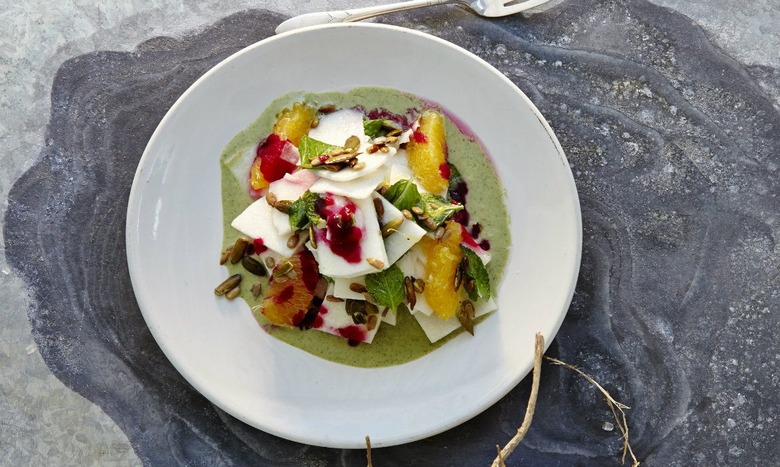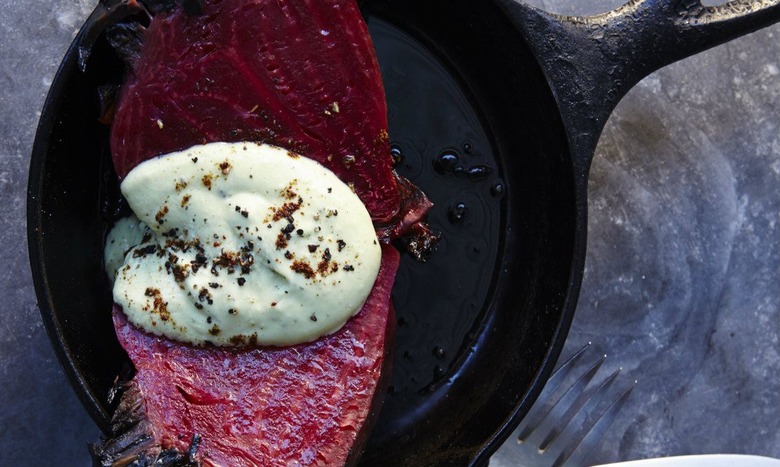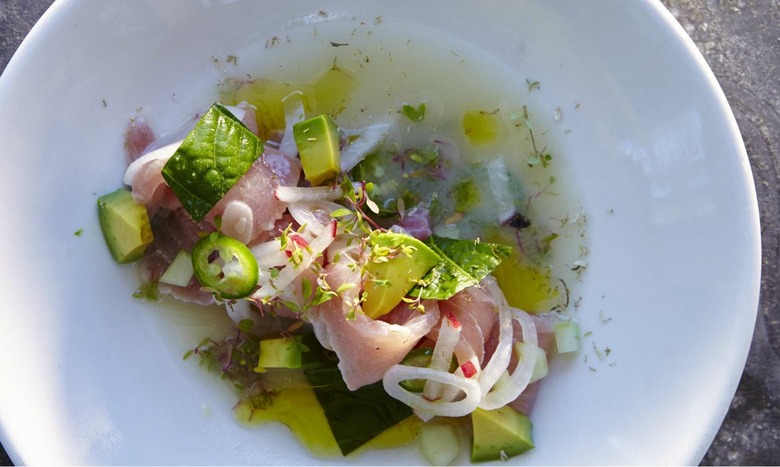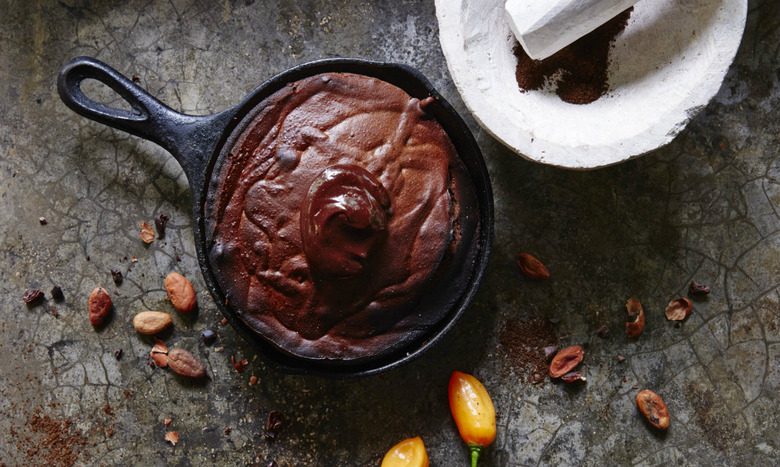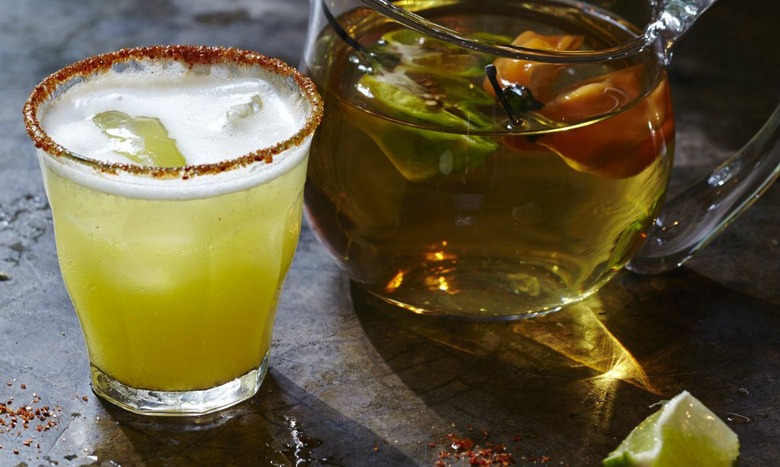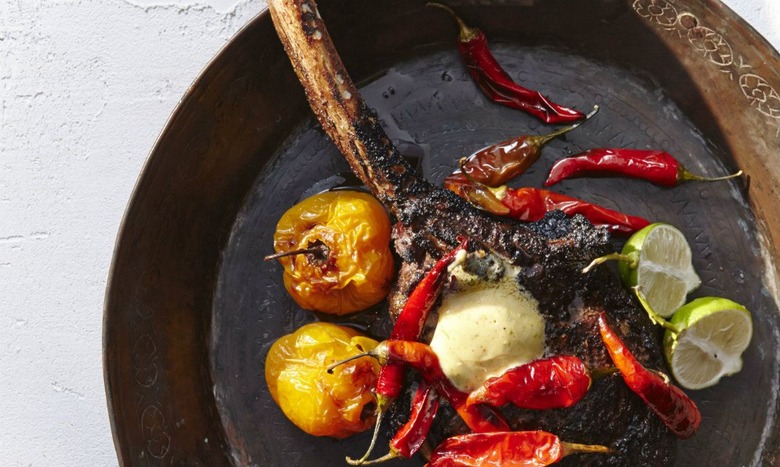Bring The Vibrant Flavors Of The Yucatán Home With 'Hartwood'
We may receive a commission on purchases made from links.
Have you ever cooked with nopales? Tasted the creamy fruit from a guanabana? Or finished a dish with a sprinkling of cotija cheese? These ingredients might sound exotic, but chances are you can find your own taste of Tulum in Anytown, U.S.A. by venturing to your local Mexican market or specialty food store.
Click here for the 10 Cookbooks Everyone Should Own slideshow.
Eric Werner and Mya Henry were tired of the long nights of work, the temperamental weather, and the general grind that frustrates every New Yorker — even the most die-hard city dweller — at some point. So they made the decision to move to paradise Tulum, Mexico, and open there own ode to food, Hartwood.
The restaurant, built in a clearing in the jungle, attracted the attention of the culinary elite around the world, including René Redzepi, who wrote the forward to their first cookbook. Hartwood, the cookbook, showcases the rich flavors of the Yucatán that the husband and wife duo cook every night at their beloved restaurant. Stoking the fires on the wood burning stove, they discovered their cooking niche in Mexico — reinventing local flavors over trained flames.
This book brings these otherwise inaccessible flavors and composed dishes to home cooks by breaking down traditional cooking techniques and explaining unusual products in a clear voice. The tools needed to make these dishes aren't complicated, so don't worry about buying a wood burning stove.
Once you've gotten over looking at the photographs of exquisite Mexican vistas and colorful dishes of food, the book asks readers to expand their minds and comfort zone by reaching for unfamiliar ingredients to create a truly authentic food experience.
We had a chance to chat with Werner about the new book, his own experiences in the kitchen, and what it was like adapting these vibrant recipes for the home cook.
The Daily Meal: What is it that first drew you to cooking?
Eric Werner: As a child, I lived in upstate New York and spent much of my time with my father in the woods, where we did a lot of cooking. I learned how rewarding it is to build a fire from scratch — it makes preparing food even more enjoyable. The fire is like the sea or the wind — a force of nature that you can direct but can't fully control.
How does that influence the food you make today?
Cooking with fire is a rewarding experience and allows you to become more connected with your food. The energy that the chef gives to the fire is what the fire gives in return. That technique gives Hartwood's food its depth and flavor.
What are some of the techniques or ingredients inspired or provided by your Yucatán surroundings that you showcase in the book?
As we traveled around the region, we became driven in our search for ingredients. Visiting the markets in the Yucatán is like being transported to another world. This area has so many ingredients that are barely documented in Spanish, never mind in English, so you need to start at the beginning. We rely on centuries-old techniques to make ingredients like the beautifully floral recado rojo paste — one of the true standards of Mayan comfort food. And of course the wide array of seafood from the Caribbean is simply amazing. There is always at least one ceviche on the menu each day. The fish we get is so exceptional it could be used in a sushi restaurant.
What is the best way for home cooks to become familiar with some of the more exotic ingredients in this book?
Our advice on finding the less-familiar ingredients: Every town now has a Mexican grocery store. You can also look for exotic fruits and produce in Asian grocery stores or at a Whole Foods or other specialty shop. Before you start ordering online, get to know your community. The best ideas start with a simple conversation with the vendors. What's the name of this? How is it used? What is it similar to? It's humbling to ask such basic questions, and this is how we discover the uses of all of the new ingredients we come across. It takes a leap of faith to understand the cooking of another culture, but once you start tasting new things, the learning becomes an experience that you will enjoy more and more.
What was the process of adapting the dishes you serve in the restaurant for this book (for the home cook)?
We adapted all of the recipes for conventional kitchens and ingredients available in the U.S. Our co-author, Oliver Strand, tested them in a home in upstate New York — about as far as you could get from Tulum, Mexico! At home, most people don't have a grill and a wood-burning oven like we do in the restaurant. But you have other options. You could cook the food entirely on the grill, or you could grill over hardwood, and then complete the dish in a preheated conventional oven, where it will cook through without being incinerated. Or, if you don't have a grill, turn up the burner on your range: Use a well-oiled cast-iron skillet brought to a high temp on the burner so that it gives a nice sear, then transfer the pan to the hot oven.
How do you hope readers will use this book?
I want readers to be able to use these recipes in daily cooking and to create dishes for their family and friends and find reward in doing so. These recipes invite you to check out fruits and vegetables that you might not always use; this is a book that should inspire exploration.
What is the ultimate take-away for readers?
The recipes that are in this book are for everyone to enjoy, so get out and explore your local Mexican grocery store and your farmer's market for new ingredients.
Anything else you would like to share about the book?
This book is meant to share our love of cooking and our love for the community that makes Hartwood possible. We're honored to be able to share our food and our story and we hope that our recipes allow readers to understand a simple way to make food delicious.
Want to try a recipe?
Jicama Salad with Mint Crema
When we inspected the plot where we would build the restaurant, we found a 20-foot-long jicama vine growing wild. It was insane. The vine was so large it was taking over entire trees.
Jicama is starchy and crisp and completely refreshing. Imagine crossing a potato, an apple, and a cucumber without the seeds. Jicama is almost entirely water by weight, so when you shop for it, look for the firmest and heaviest. You want the skin to be tight, not wrinkled.
We garnish this salad with prickly pear preserves, but you could use a handful of ripe watermelon cubes instead. And, yes, the mint crema recipe makes double what you'll need, but we promise you'll want to make this salad again. — Eric Werner
Roasted Beets with Avocado-Habañero Crema
We keep stalks of sugarcane in a galvanized bucket on the table in front of the wood-burning stove, using them to flavor a roast the way other restaurants might use a few sprigs of thyme or rosemary. We split open a piece and throw it into the pan to highlight whatever natural sweetness will be brought out by the fire. When we get a delivery of sugarcane, we hack the long stalks in two-foot pieces with a machete; you might be able to find smaller pieces in a Mexican grocery or even at Whole Foods. — Eric Werner
For the Roasted Beets with Avocado-Habañero Crema recipe, click here.
Ceviche de Aguja with Ginger and Mezcal
The earthy, smoky flavor of the mezcal sets up both the sharpness of the citrus in the marinade and the fattiness of the avocado. When shopping for marlin, look for a lean fillet with no fatty layers between the muscles — that fat is too chewy for a ceviche. If you can't find lean marlin, ask for lean swordfish. If the only marlin (or swordfish) at the fish market is fatty, then don't make ceviche: Those cuts are best roasted in the oven. — Eric Werner
For the Ceviche de Aguja with Ginger and Mezcal recipe, click here.
Chocolate Habañero Cake with Chocolate Avocado Buttercream
In Mexico, the pairing of chocolate and chile goes back hundreds of years. No news there. But the avocado buttercream is a new innovation. The avocado gives the frosting a really interesting vegetal note, and probably some nutritional value, yet it's so rich it's like throwing in an extra stick of butter. Chill the frosted cake before serving to allow the buttercream to set. At Hartwood, we bake the cake in a cast-iron skillet, but this recipe is for cake pans.
This cake is quite spicy — you may want to use less chile powder the first time you make it. — Eric Werner
For the Chocolate Habañero Cake with Chocolate Avocado Buttercream recipe, click here.
Piña-Habañero Margarita
Thick, fruity, spicy: This is a margarita with a lot of personality. It's also a drink best made in batches. If you do your prep ahead of time (infuse the tequila with the habañero 36 hours before; purée fresh pineapple in a blender earlier in the day), you can mix together one round after another after your guests arrive. A trick from behind the bar: Shake the drink and pour two-thirds of it into the glass, then shake the rest of the drink again before topping it off, so that the margarita has a slightly frothy head. — Eric Werner
Ribeye with Pepita-Lime Butter
This recipe is for an enormous ribeye, a special occasion cut. The total cooking time is 20 minutes, so you want to rest it for 10 minutes — five minutes on either side. Follow this formula for all the meat you grill (skirt steak, lamb, pork), and you'll notice the difference. — Eric Werner
For the Ribeye with Pepita-Lime Butter recipe, click here.
Angela Carlos is the Cook Editor at The Daily Meal. Find her on Twitter and tweet @angelaccarlos.
